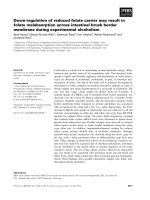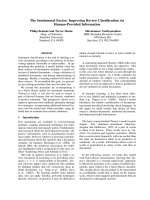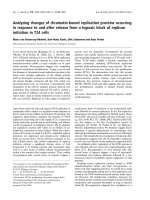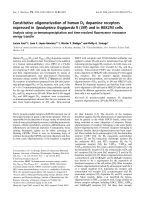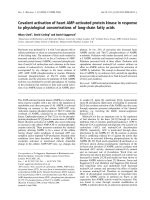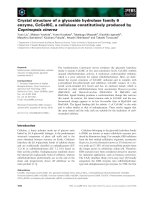Báo cáo khoa học: "The growth of spruce (Picea abies (L) Karst) in the Krkonoše-(Giant) Mountains as indicated by ring width and wood density" docx
Bạn đang xem bản rút gọn của tài liệu. Xem và tải ngay bản đầy đủ của tài liệu tại đây (453.56 KB, 10 trang )
Original
article
The
growth
of
spruce
(Picea
abies
(L)
Karst)
in
the
Krkonoše-(Giant)
Mountains
as
indicated
by
ring
width
and
wood
density
C
Sander
D
Eckstein
J
Kyncl
J
Dobrý
1
Institute
for
Wood Biology,
University
of
Hamburg,
Leuschnerstraße
91,
D-21031
Hamburg,
Germany;
2
Institute
of
Botany,
Czech
Academy
of
Sciences,
CZ-252 43
Pruhonice,
Czech
Republic
(Received
8
July
1994;
accepted
23
November
1994)
Summary —
The
spruce
forests
near
the
upper
tree
line
in
the
Krkonoše
Mountains
(Czech
Repub-
lic)
are
damaged
by
air
pollution.
Along
an
altitudinal
transect,
141
spruces
have
been
investigated
to
find
out
whether
pollution
has
affected
cambial
activity
indicated
by
changes
in
tree-ring
width,
maxi-
mum
latewood
density
and
a
changing
growth
response
to
climate.
Under
severe
pollution
impact,
a
decline
in
both
tree-ring
width
and
maximum
density
was
apparent.
Correlation
and
multiple
regression
analyses
of
growth
and
climate
point
to
a
reduced
length
of
the
growth
period
in
the
last
2
decades.
A
possible
relation
to
pollution
impact
is
discussed.
Norway
spruce
/
tree
ring
/ latewood
density
I
pollution
I
climate
Résumé — Croissance
de
l’épicéa
commun
(Picea
abies
(L)
Karst)
dans
les
monts
Krkonoše :
détermination
par
la
mesure
de
la
largeur
des
cernes
et
de
la
densité
du
bois.
Les
peuplements
d’épicéa
commun
(Picea
abies
L
Karst)
situés
à
proximité
de
la
limite
altitudinale
des
arbres
dans
les
monts
Krkonoše
(République
tchèque)
sont
affectés
parla
pollution
atmosphérique.
Un
échantillon
de
141
arbres
a
été
sélectionné
le
long
d’un
gradient
altitudinal pour
examiner
l’effet
de
la
pollution
sur
l’acti-
vité
cambiale
par
le
biais
des
variations
de
la
largeur
des
cernes
de
croissance,
de
la
densité
maximale
du
bois
final
ainsi
que
de
la
réponse
de
ces
2
paramètres
au
climat.
Les
niveaux
élevés
de
pollution
sont
associés
à
une
baisse
de
la
largeur
des
cernes
de
croissance
ainsi
que
de
la
densité
maximale.
Des
analyses
de
corrélation
et
des
régressions
multiples
indiquent
une
réduction
de
la
période
de
croissance
depuis
quelques
années.
Le
rôle
possible
de
la
pollution
atmosphérique
est
discuté.
épicéa / cerne
annuel/densité
du
bois
final/pollution/climat
*
Correspondence
and
reprints
INTRODUCTION
The
old
growth
spruce
forests
near
the
upper
tree
line
in
the
Krkonoše
Mountains
in
the
Czech
Republic
are
among
the
most
damaged
forests
in
Europe.
Defoliation
of
the
trees
was
recorded
as
early
as
1979
(Vacek
and
Lepš,
1987).
A
preliminary
den-
droecological
investigation
in
the
upper
Labe
(Elbe)
Valley
revealed
a
growth
depression
since
about
1970
and
a
subsequent
recov-
ery
since
the
mid
1980s
(Dobrý
et al,
1992).
The
objective
of
the
present
study
is
to
examine
changes
in
tree-ring
width
and
maximum
latewood
density
as
well
as
the
changing
response
of
the
trees
to
climate,
indicative
of
pollution-induced
changes
in
the
cambial
activity
of
spruce.
MATERIALS
AND
METHODS
Altogether,
7
study
sites
were
selected
along
an
elevational
transect
from
1
000
to
1
300
m
asl
through
the
Labe
Valley.
On
the
southern
slope,
90
spruces
were
sampled
on
5
sites
(sites
71-75);
on
the
northern
slope,
51
spruces
on
2
sites
(sites
77,
78)
were
selected.
Tree
age
was
between
70
and
220
years.
Two
cores
per
tree
were
taken
for
both
the
measurement
of
the
annual
increment
and
the
wood
density.
The
cor-
ing
was
done
parallel
to
the
slope
to
avoid
com-
pression
wood.
The
tree-ring
widths
were
measured
with
an
accuracy
of
1/100
mm
on
a
measuring
device
developed
by
Aniol
(1987).
The
ring-width
series
were
visually
cross-dated,
checked
and
corrected
for
missing
and
false
rings,
and
statistically
veri-
fied
using
the
program
COFECHA
(Holmes
et al,
1986).
Those
ring-width
series,
or
parts
of
them,
showing
poor
correlation
with
the
so-called
mas-
ter
chronology,
were
excluded
from
further
anal-
ysis
and
the
remaining
series
were
averaged
per
tree.
In
order
to
differentiate
exogenous
distur-
bances
from
other
growth
influences,
the
series
were
detrended
to
eliminate
the
age
trend
and
other
long-term
fluctuations
(=
standardization)
using
the
program
ARSTAN
(Holmes
et al,
1986).
In
the
first
step,
the
program
fits
a
negative
expo-
nential
function
or
regression
line
to
each
of
the
series
and
an
index
series
was
obtained.
In
a
second
step,
a
cubic
spline
(66
years
stiffness)
was
fit
to
these
index
series.
Remaining
auto-
correlation
was
removed
by
autoregressive
mod-
eling.
The
resulting
series
were
aggregated
by
robust
mean
calculation
into
site-specific
chronolo-
gies.
A
principal
component
analysis
(PCA)
of
the
total
variation
of
all
site
chronologies
was
then
computed
to
point
out
common
patterns
of
the
tree-ring
width
variation.
Maximum
latewood
density
was
measured
by
X-ray
densitometry
according
to
Schweingruber
(1983)
with
an
accuracy
of
0.001
g/cm
3.
The
den-
sity
series
were
dated
and
statistically
treated
as
described
earlier
for
the
ring-width
series,
except
that
only
a
1-step
detrending
was
performed
by
fit-
ting
a
cubic
spline;
autoregressive
modeling
was
skipped
because
density
series
showed
minor
long-term
fluctuations
and
extremely
low
auto-
correlation.
Like
the
ring-width
series,
the
den-
sity
series
were
averaged
by
robust
mean
cal-
culation
into site
chronologies.
The
climatic
data
used
for
calculating
cli-
mate-growth
relationships
contained
time
series
of
mean
temperature
and
the
sum
of
precipita-
tion
per
month
from
the
Snezka
Mountain
(1
603
m
asl),
Harrachov
(706
m)
and
Jakuszyce
(871/910
m)
stations.
The
data
were
checked
for
homogeneity
and
then
aggregated
into
a
regional
climate
chronology.
Climate-growth
relationships
were
computed
by
simple
correlation
and
multiple
regression
analyses
for
the
periods
before
and
during
severe
air
pollution
impact
from
1931
to
1960
and
from
1961
to
1990,
respectively.
The
cli-
matic
data
were
used
as
1
variable
and
the
chronologies
of
ring
width
and
wood
density
indices
as
the other
variables.
Multicollinearity
was
avoided
by
using
the
principal
components
of
the
climatic
data.
These
computations
were
con-
ducted
with
the
program
RESPO
(Lough,
1984;
Holmes,
1994).
Since
response
functions
are
sensitive
to
default
parameters
set
in
the
pro-
gram
such
as
confidence
level,
number
of
eigen-
vectors
and
climatic
parameters
(Blasing
et
al,
1984),
correlation
analysis
was
also
used
as
a
means
of
confirming
the
resulting
response
func-
tion.
RESULTS
AND
DISCUSSION
The
pattern
of
the
ring-width
series
was
very
similar
for
all
sample
sites
on
the
southern
as
well
as
the
northern
slope.
The
same
was
true
for
the
latewood
density
series.
However,
there
was
no
correspondence
between
these
2
parameters.
Since
the
PCA
did
not
reveal
any
grouping
of
the
sites,
slope
chronologies
for
tree-ring
width
and
latewood
density
were
built.
In
table
I,
the
statistics
of
both
the
ring
width
and
the
den-
sity
time
series
are
summarized.
Tree-ring
width
The
mean
ring
width
of
all
trees
investigated
was
1.42
mm
on
the
southern
slope
and
1.57
mm
on
the
northern
slope.
Up
to
the
1960s,
the
trees
on
both
exposures
along
the
Labe
River
show
the
same
growth
level
(fig
1);
the
annual
increments
decreased
slowly
from
the
pith
outwards.
After
1930,
the
years
1942,
1956,
1974
and
1980
are
striking
pointer
years
obviously
caused
by
climatic
influences:
in
1942
and
1956
there
were
extreme
frost
events
in
January/Febru-
ary,
and
in
1974
and
1980
cold
summers
caused
small
increments.
From
about
1965
the
southern-slope
chronology
diverged
from
the
northern-slope
chronology:
whereas
the
spruces
on
the
northern
slope
showed
a
slightly
decreasing
increment
until
the
late
1970s
and
only
a
few
years
of
growth
depression
from
1980,
a
long-lasting
period
of
severe
growth
depression
occurred
in
the
southern-slope
chronology.
The
trees
started
to
recover
as
recently
as
the
late
1980s.
From
1974
on,
an
increasing
number
of
missing
and
wedging
rings
were
detected
in
many
spruces
on
sites
71-75
(southern
slope),
but
only
in
a
few
trees
on
sites
77
and
78
(northern
slope).
In
all,
371
(=
1.2%)
of
the
tree
rings
of
the
southern-slope
spruces
but
only
54
(0.5%)
of
the
northern-
slope
spruces
were
partly
or
totally
missing.
There
was
no
apparent
influence
of
tree
age
on
this
phenomenon.
Old
as
well
as
younger
trees
showed
disturbances
in
their
cambial
activity.
Maximum
latewood
density
Density
series
of
the
spruces
on
the
northern
and
southern
slopes
showed
a
higher
simi-
larity
than
ring-width
series
(fig
2).
According
to
correlation
analysis,
the
strength
of
the
common
signal
was
higher
in
maximum
den-
sity
than
in
ring
width.
Whereas
correlation
coefficients
for
the
ring
widths
reached
0.43
and
0.37
(chronologies
of
southern
and
northern
slope,
respectively),
a
coefficient
of
0.63
was
obtained
for
maximum
density
(table
I).
Until
the
early
1960s,
maximum
latewood
density
fluctuated
around
an
aver-
age
level
of
approximately
0.7
g/cm
3.
In
the
recent
period,
density
has
been
decreasing
to
below
0.5
g/cm
3.
A
comparable
reduc-
tion
was
achieved
only
in
1912
when
almost
no
latewood
was
formed
(eg,
Kyncl
et
al,
1990).
The
decline
of
maximum
density
can
be
caused
by
air-pollution
impact.
For
exam-
ple,
Keller
(1980)
and
Eckstein
et al (1995)
showed
a
decreasing
amount
of
latewood
production
and
a
lower
latewood
density
in
spruce
under
the
influence
of
SO
2
in
fumi-
gation
chambers.
A
comparison
between
tree-ring
width
and
density
chronologies
showed
no
sig-
nificant
correlation.
This
phenomenon
indi-
cates
that
different
factors
affect
cambial
activity,
expressed
by
ring
width,
and
cell
differentiation
expressed
by
density.
Climate-growth
relationship
Temperature
proved
to
be
the
most
domi-
nant
growth-limiting
factor
for
tree-ring
width
and
density.
This
would
seem
to
be
reliable
since
the
mean
annual
temperature
in
the
Labe
Valley
does
not
exceed
4°C.
Precipi-
tation,
however,
reaches
more
than
1
300
mm
per
year
and
is
therefore
unlikely
to
be
a
limiting
factor
(Vacek,
1981).
On
the
con-
trary,
there
is
even a
slight
tendency
for
high
amounts
of
rainfall
to
reduce
tree
growth
(fig
3).
The
aspect
of
the
sites
had
no
effect
on
the
trees’
response
to
climate.
As
was
hypothesized
from
the
compari-
son
of
the
ring
width
and
density
chronolo-
gies,
the
climate-growth
relationships
of
these
parameters
were
different
(figs
3,
4).
In
general,
maximum
latewood
density
reflected
climatic
influences
more
than
ring
width
did.
Eighty
to
94%
of
the
variance
in
the
density
chronologies
and
61
to
77%
in
the
ring-width
chronologies
could
be
explained
by
climate.
Recently,
climatic
impact
on
ring
width
has
been
decreasing,
but
climatic
impact
on
maximum
density
has
been
increasing.
From
1931
to
1960,
ring
width
was
affected
by
summer
temperature
(May
to
July).
In
the
period
from
1961
to
1990,
the
temperature
of
June
alone
was
significant.
Maximum
latewood
density
was
significantly
influenced
by
temperature
in
early
spring
(April/May)
and
late
summer
(August)
from
1931
to
1960.
From
1961
to
1989,
the
period
of
influence
was
shortened
to
May
and
July.
To
visually
depict
the
climatic
influence
on
both
growth
parameters,
the
respective
index
chronologies
were
plotted
versus
the
record
of
the
aggregated
temperature
data
that
had
been
shown
to
be
significant
(figs
5,
6).
In
the
ring-width
chronologies,
the
most
distinct
pointer
years
(1965,
1974,
1980)
can
be
explained
by
cold
summers;
in
1940
and
1956,
extreme
frosts
in
January/Febru-
ary
likely
affected
growth
in
the
vegetation
periods
that
followed.
Pointer
years
in
max-
imum
density
(1940,
1957, 1962,
1980)
were
caused
by
low
temperature
in
May
and/or
in
late
summer.
The
significant
rela-
tionship
between
precipitation
in
April/July
and
density
was
due
to
a
few
extreme
data
points
or
was
caused
indirectly
by
temper-
ature
(high
temperature
corresponded
with
low
precipitation)
and
was
not
taken
into
further
consideration.
It
can
be
summarized
that
ring
width
is
mainly
correlated
with
temperature
during
the
vegetation
period,
whereas
latewood
density
mainly
varies
due
to
temperature
at
the
very
beginning
and
the
very
end
of
the
vegetation
period.
This
corresponds
with
results
obtained
for
white
spruce
near
the
northern
tree
line
(D’Arrigo
et al,
1992)
as
well
as
for
different
conifers
in
the
Alps
and
Scotland
(Schweingruber
et al,
1979).
Cell-
wall
thickening
in
late
summer
seems
to
be
connected
with
growth
conditions
in
early
spring,
which
affect
the
content
of
growth
regulators,
the
development
of
the
photo-
synthetic
apparatus
and
the
long-term
sup-
ply
of
photosynthates.
Under
extreme
cli-
matic
conditions
near
the
upper
tree
line,
the cessation
of
cambial
activity
and
cell
dif-
ferentiation
is
not
only
related
to
the
day
length
but,
predominantly,
to
temperature.
Short
vegetation
period
and
frost
events
that
may
occur
in
summer
can
cause
the
cessation
of
cambial
activity
and
affect
the
duration
of
cell-wall
thickening.
This
might
explain
the
close
relation
of
latewood
density
to
temperature
in
July
and
August.
In
the
recent
period,
when
trees
have
grown
under
the
impact
of
severe
pollution,
the
spruces
in
the
upper
Labe
Valley
showed
an
increasing
occurrence
of
wedg-
ing
and
missing
tree
rings.
This
serious
dis-
turbance
of
cambial
activity
points
to
a
lack
of
supply
of
assimilates
and
auxine.
More-
the
significant
impact
of
temperature
on
both
ring
width
and
latewood
density
started
later
and
ended
earlier
in
the
year.
Since
there
are
no
data
available
on
the
periodicity
of
cambial
activity
of
spruce
in
the
upper
Labe
Valley,
this
result
must
be
discussed
further.
This
phenomenon
implies
that
the
period
of
cambial
activity
might
have
been
shortened
under
pollution
stress.
Such
a
result
has
been
observed
by
Götsche-
Kühn
(1988)
in
spruces
showing
severe
needle
loss:
the
duration
of
cambial
activity
was
reduced
by
60%
relative
to
the dura-
tion
observed
in
healthy
trees.
This
can
be
explained
by
pollution-caused
inhibition
of
photosynthesis
and
synthesis
of
hormonal
growth
regulators
which
are
dependent
on
the
development
of
buds
and
shoots
(Kozlowski,
1986);
this
may
also
hold
true
in
the
Labe
Valley.
An
additional
effect
of
climate
is
also
con-
ceivable.
It
has
to
be
considered
that
the
mean summer
temperature
has
decreased.
The
mean
July
and
August
temperatures
during
the
period
from
1961
to
1989
recorded
at
Snezka
Mountain
were
8.0/8.0°C
compared
to
8.7/8.5°C
for
the
30
years
before.
Under
the
growth
conditions
along
the
upper
tree
line,
this
may
have
con-
tributed
to
shorten
the
vegetation
period.
However,
mean
spring
temperature
did
not
change,
thus
the
later
initiation
of
cambial
activity
cannot
be
explained
by
climate.
ACKNOWLEDGMENTS
We
would
like
to
thank
LD
Daniels,
University
of
British
Columbia,
Vancouver,
BC,
Canada
for
the
revision
of
the
English
version
of
the
manuscript.
REFERENCES
Aniol
R
(1987)
A
new
device
for
computer
assisted
mea-
surement
of
tree-ring
width.
Dendrochronologia
5,
135-141
Blasing
TJ,
Solomon
AM,
Duvick
DN
(1984)
Response
functions
revisited.
Tree-Ring
Bull 44,
1-15
D’Arrigo
RD,
Jacoby
GC,
Free
RM
(1992)
Tree-ring
width
and
maximum
latewood
density
at
the
North
American
tree
line:
parameters
of
climatic
change.
Can
J
For
Res
22, 1290-1296
Dobrý
J,
Eckstein
D,
Sander
C,
Kyncl
J
(1992)
Den-
droecological
and
technological
studies
on
spruce
trees
in
the
Krkonoše
Mts.
In:
Proc
VI Intern
Conf
1521
September
1991
(J
Bohá&jadnr;,
ed),
Ceské
Bude-
jovice,
Czechoslovakia,
117-122
Eckstein
D,
Scholz
F,
Klein
H
(1995)
Wood
anatomical
studies
on
cloned
spruce
trees
fumigated
with
sul-
phur
dioxide.
IAWA
J
16
(in
press)
Götsche-Kühn
H
(1988)
Bildung
und
Eigenschaften
des
Holzes
von
Fichten
(Picea
abies
(L)
Karst)
aus
Wald-
schadensgebieten.
[Formation
and
properties
of
Nor-
way
spruce
(Picea
abies
(L)
Karst)
wood
from
forest
decline
areas.]
Mitteilungen
der
Bundes-
forschungsanstalt
für
Forst-
und
Holzwirtschaft
Nr
157,
Hamburg
Holmes
RL
(1994)
Dendrochronology
program
library
users
manual.
Laboratory
of
tree-ring
research,
Uni-
versity
of
Arizona,
Tucson,
AZ,
USA
Holmes
RL,
Adams
RK,
Fritts
HC
(1986)
Tree-ring
chronologies
of
western
North
America,
California,
eastern
Oregon
and
northern
Great
Basin.
Chronol-
ogy
Series
IV,
University
of
Arizona,
Tucson,
AZ,
USA
Keller
T
(1980)
The
effect
of
a
continuous
springtime
fumigation
with
SO
2
on
CO
2
uptake
and
structure
of
the
annual
ring
in
spruce.
Can
J
For
Res
10,
1-6
Kozlowski
TT
(1986)
Responses
of
woody
plants
to
envi-
ronmental
pollution.
For Abstr 47,
106-132
Kyncl
J,
Dobrý
J,
Munzar
J, Sarajishvili
K
(1990)
Tree-ring
structure
response
of
conifers
in
Europe
to
weather
conditions
in
1912
(with
regard
to
the
volcano
Katmai
eruption).
In:
Proc
Intern
Conf
climatic
changes
in
the
historical
and
the
instrumental
periods
(R
Brázdil,
ed),
Brno,
Czechoslovakia
Lough
J
(1984)
Technical
note
no
35,
Program
instruc-
tions
and
computer
output
related
to
climatic
causes
and
climatic
regimes
projects:
1982-1986.
In:
Cli-
matic
variations
for
North
America
and
the
North
Pacific,
Laboratory
of
tree-ring
research,
University
of
Arizona,
Tucson,
AZ,
USA
Schweingruber
FH
(1983)
Der Jahrring:
Standort,
Methodik,
Zeit
und
Klima
in
der
Dendrochronologie.
Haupt-Verlag
Bern,
Stuttgart
Schweingruber
FH,
Bräker
OU,
Schär
E
(1979)
Den-
droclimatic
studies
on
conifers
from
central
Europe
and
Great
Britain.
Boreas
8, 427-452
Vacek
S
(1981)
V&jadnr;ková
struktura
autochtonní
smrciny
v
Krkonošich.
[Age
structure
of
the
autochthonous
spruce
forest
in
the
Krkonoše
Mts.]
Lesnictví 27,
213-228
Vacek
S,
Lepš
J (1987)
Changes
in
the
horizontal
struc-
ture
in a spruce
forest
over a 9-year
period
of
pollu-
tant
exposure
in
the
Krkonoše
Mountains,
Czechoslo-
vakia.
For
Ecol
Managem
22,
291-295
